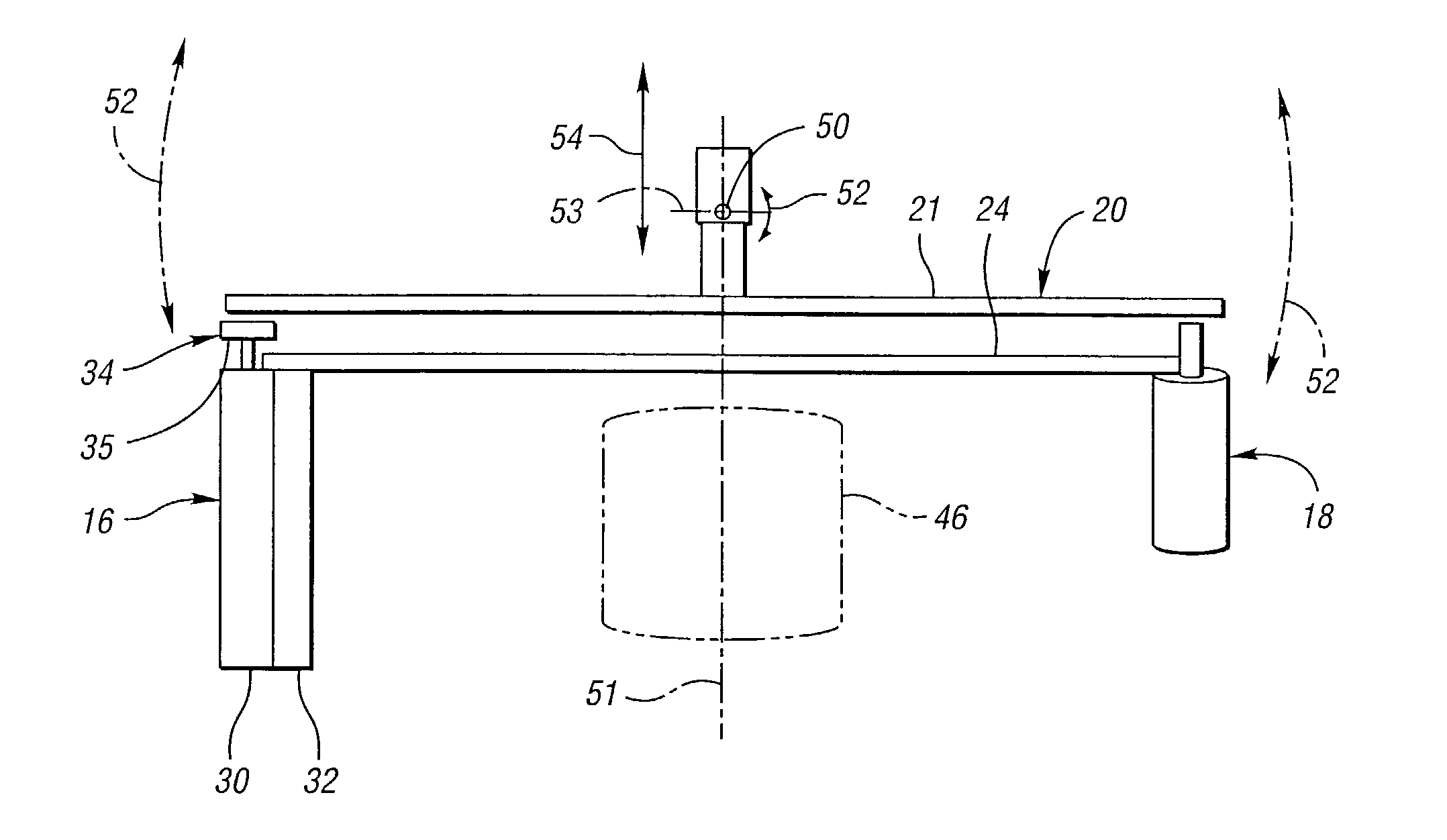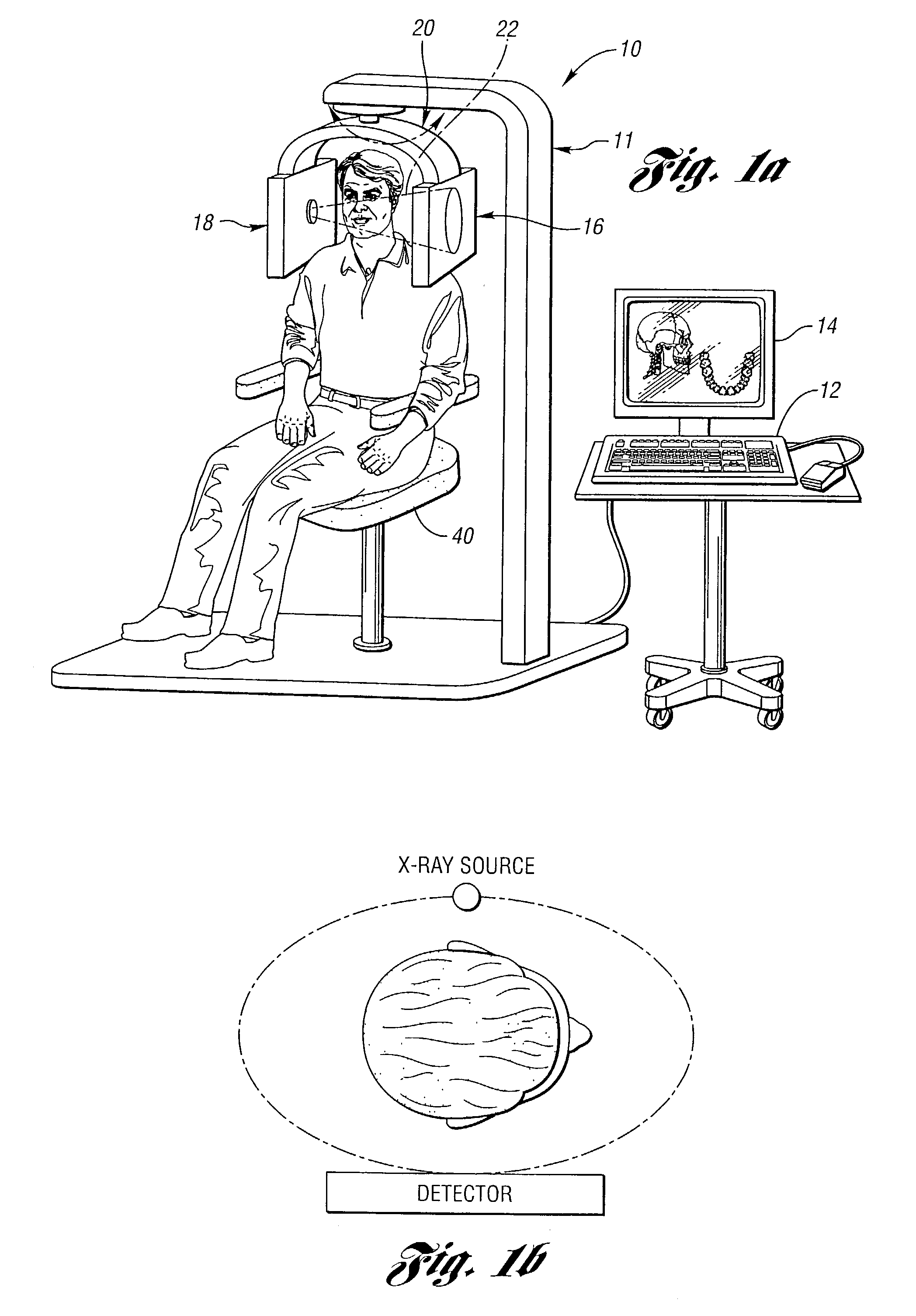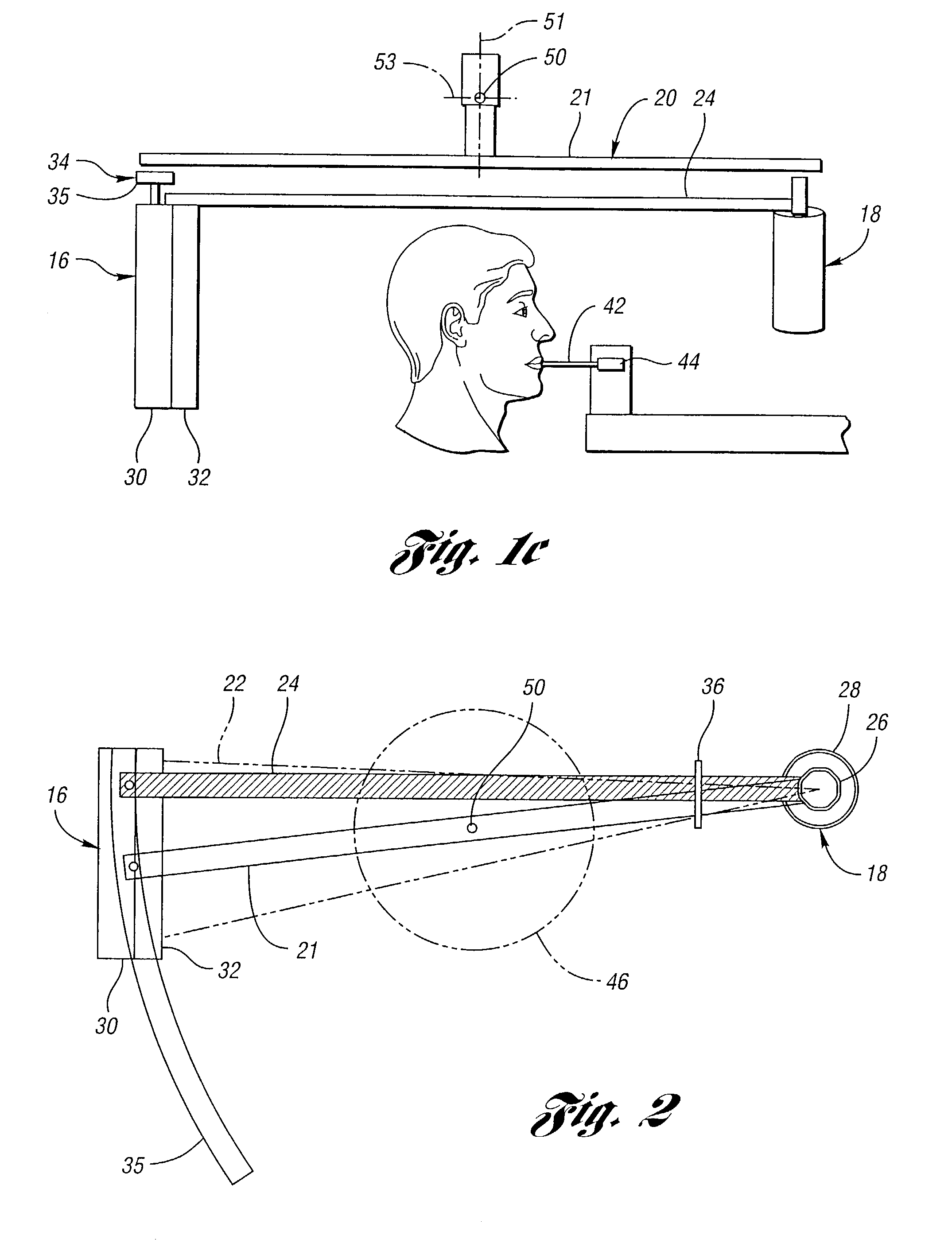A number of
imaging modalities have been used over the years, but they all have limitations and none are completely satisfactory.
In addition, periapical radiographs are only two-dimensional images and do not provide information about the third, bucco-lingual, dimension.
However, there are a large number of disadvantages to this technique that limit its usefulness for
implant site assessment.
The two primary problems are lack of information in the bucco-lingual plane and variability of the degree of
magnification in different parts of the image due to changing distance between the rotational center, jaw structures, and film as the X-ray beam rotates around the head.
Minor errors in positioning the patient's head in the
machine can also exaggerate the degree of enlargement variability, particularly in the horizontal direction.
Although dentists frequently try to overcome these
magnification problems by having the patient wear a surgical
stent with
metal markers of a known size during the examination, this device is not adequate to solve all
distortion errors.
Conventional tomographs, however, have been reported not to be of
diagnostic quality sufficient to allow identification of the canal in as many as 20% of cases.
This is primarily due to the unavoidable blur that is inherent in the method, although some canals are poorly corticated and thus would be difficult to visualize with any technique.
Another very important
disadvantage of conventional
tomography is that it is usually necessary to acquire multiple slices to ensure that the region of diagnostic interest is sampled adequately.
Because each slice is acquired successively, the process is time-consuming and laborious, thus expensive, and it exposes the patient to a
radiation dose that can be high, depending on the number of slices obtained.
Conventional CT has its drawbacks, however.
First, with its merely 2-D reformatted images, it may not clearly depict the inferior alveolar canal.
Second, it is time-consuming: conventional CT requires more than 20 minutes to get all the axial slices for a
dental implant study.
With such a long scanning time, patient fatigue and patient
swallowing start blurring the image.
Fourth, it is expensive.
Fifth, it suffers from poor resolution, especially in the z-direction.
Sixth,
metal streak artifacts can occur in the presence of metallic dental restorations, requiring judicious selection of scan orientation and boundaries to minimize its occurrence.
The use of TACT in implantology has been suggested, but no
controlled studies have yet been performed.
This adds to the complexity of operating the instrument.
In this context, the term “partial CT scan” refers to a cone-beam CT scan using a
circular orbit, which, in addition to having the usual cone-beam incompleteness problem (i.e., a
circular orbit does not satisfy Tuy's completeness conditions), is more incomplete in the sense that the data is insufficient for quantitatively reconstructing 3-D cross-sectional images to the use of a detector and scan geometry that do not measure all necessary rays through the object.
However, the applicability of Ortho-CT in
implant planning is limited for four reasons.
This is a consequence of its use of incomplete data.
Fourth, although its behavior in the presence of metal fillings has not been reported on, it is expected that it suffers from metal streak artifacts.
It can display the mesial and distal aspects of the
implant site, but it provides little information about the facial and lingual aspects of the implant site because of the obscuring effects of the radiopaque
implant material.
Its other major limitations include the subjective interpretation of the radiographic image, lack of sensitivity, and the inability to quantify
bone mass.
The
exposure factors and
processing parameters that affect density and contrast must be consistent between the two scans and the projection geometry must be duplicated as nearly as possible All this makes the method laborious and inefficient, especially when the medium is film, which is often the case.
Finally, it cannot overcome the obscuring effects of a
metal implant sufficiently to allow reliable detection of facial and lingual bone loss at implant sites.
However,
tomography of the TMJ is technically demanding because the imaging protocol must be customized for each patient due to the variability of condylar angles.
Images made with linear-motion machines may also be suboptimal due to streaking artifacts and incomplete blurring of adjacent structures.
Evaluation of articular disk position and function is usually performed with
magnetic resonance imaging or arthrotomography, again both expensive techniques.
Another important problem in
dentistry is the determination of the location and displacement of facial fractures in patients who have suffered trauma to the maxillofacial region.
Conventional
radiography is unsuitable for the task because it requires multiple scans to obtain all the views that are necessary for evaluation.
Even with a series of radiographs, it is sometimes difficult to detect subtle fractures.
However, the use of
spiral CT for detecting facial fractures has drawbacks.
It also suffers from metal streak artifacts, which can result in misleading scans of the facial complex.
While conventional
radiography produces adequate bone images, it provides little information regarding soft tissues as a result of the inability of film-screen systems to
record X-ray attenuation differences of less than 2%.
Although CT has proven superior in many aspects to other modalities in this application, its use has been limited by three factors: cost,
radiation dose and metal streak artifacts.
In addition, the spatial resolution available in current
CT scanners, which are designed primarily for full-body imaging, may not be optimal for lesions in the
head and neck.
MRI, however, is more expensive than CT, and requires a longer time to obtain a scan.
However, facial
reconstructive surgery presents a three-dimensional problem of anatomical rearrangement and cannot be effectively planned using two-dimensional images.
Morever, some facial and skeletal anomalies, specifically those involving facial
asymmetry, are not amenable to analysis using only two-dimensional images.
However, both are expensive.
In addition, CT suffers from metal streak artifacts and exposes the patient to a high
radiation dose while MRI is not particularly useful for examining bony structures.
Ortho-CT is a vertically oriented device that acquires a partial CT scan, and while spatial resolution is adequate, the device suffers from artifacts due to the incomplete nature of the scan and does not produce quantitatively accurate estimates of attenuation (necessary for assessing
bone quality).
Although images reconstructed from TomCAT have spatial resolution similar to conventional general-purpose CT instruments,
contrast resolution is quite poor and images appear to suffer from a great deal of X-ray scatter (and perhaps veiling glare from the
image intensifier).
 Login to View More
Login to View More 


